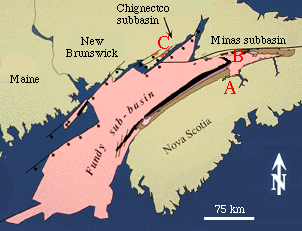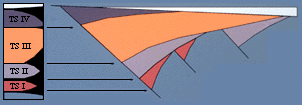FUNDY BASIN

The Fundy basin consists of 3 connected subbasins that lie mostly submerged
beneath the greater Bay of Fundy and Gulf of Maine. Together they comprise
the largest exposed Triassic-Jurassic rift basin in Eastern North America.
The Fundy
basin is the most similar of all the eastern North American basins to
the Moroccan basins, having nearly a perfect match to many of the units
seen there.
|

Above is a diagram depicting the major tectonostratigraphic
divisions of eastern US early Mesozoic basins within the basic half
graben
geometry of the basins (from Olsen, 1977).
Of all the basins in eastern North America, only the Funy basin is known to have all four tectonostratigraphic divisions.
In the Fundy basin TS I
consists of the Honeycomb Point Formation of probable Late Permian Age;
TS II consits of the Wolfville Formation of Middle Triassic (Anisian -
?Ladinian) to early Late Triassic (Carnian) age; TS III consists of the
Blomidon Formation of late, Late Triassic age (Norian - Rhaetian) age;
and TS IV consists of the uppmost Blomidon Formation, North Mountain
Basalt (part of the CAMP) of latest Triassic and Early Jurassic
(Rhaetian - Hettangian) age.
|
Areas of Interest
A. Minas Subbasin South Shore: Outcrops
along the hinge margin of Fundy basin near Wolfville, Nova Scotia
on the southern shore of the Minas subbasin include sedimentary strata of Triassic
and earliest Jurassic age and the North Mountain Basalt of Early
Jurassic age
(part of the CAMP) (TS II - IV). Compared to the outcrops on the north shore of the
Fundy basin (below), the stratigraphy and structure is simple.
B. Minas Subbasin North Shore: Outcrops
anlng the complex, northern, strike slip side of Minas subbasin of
Fundy basin include sedimentary strata of Triassic and
Jurassic age and the North Mountain Basalt of Early Jurassic age (TS II - IV)
basically similar to the strata on the south shore (above). However, in
some areas there were syn-extension micro-basins formed during oblique
extension and spectacular
eolian and volcanoclastic deposits. The Fundy Geological Museum
is also in this part of the basin and there you can see many of
the fossils, inckuding dinosaurs, that have been found in this area.
C. Chignectco Subbasin:
Outcrops along the west side of the Chignectco subbasin lie along a
largely dip-slip border fault system. Outcrop reveal Late Permian
strata unconformably overlain by Triassic strata (TS I - II).
References:
Olsen, P. E. 1997. Stratigraphic record
of the early Mesozoic breakup of Pangea in the Laurasia-Gondwana rift system.
Annual Reviews of Earth and Planetary Science v. 25, p. 337-401.
Back
to FIELD TRIPS - A VIRTUAL SAMPLER OF THE STOPS TO BE
Back
to PANGEA WORKSHOP HOME PAGE.

